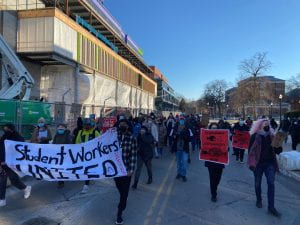As you may already know, this past Tuesday, 1/4/22, the Ohio State University President, Kristina M. Johnson, sent out an email detailing the university’s COVID-19 policies going into Spring Semester of 2022. This email and its contents regarding these “policies” provide no genuine action plan on how to safely tackle getting an education amidst a worsening pandemic, and ultimately serve as a gesture at best.
This screenshot from the CDC’s data tracker represents the “dramatic increase in COVID infections” that President Johnson alluded to in the beginning of her email. As can be seen, the entirety of the United States is experiencing a high rate of transmission and positive testing. This rate is the highest since the pandemic began.
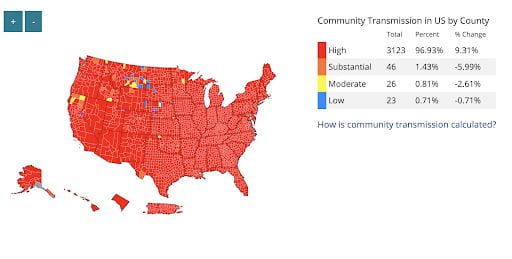
To be more specific and relevant to our situation, Ohio’s rate of transmission is following a similar trend.
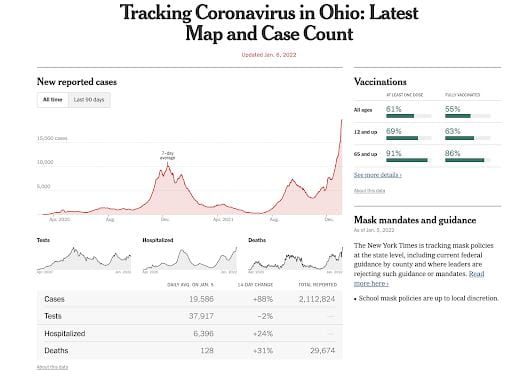
According to the New York Times’ COVID tracker, shown above for ease, it can be seen that Ohio is also currently experiencing the highest rate of transmission and positive testing since the pandemic began.(1)
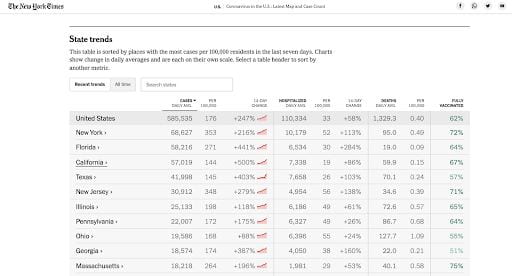
And in this infographic, we can see even more so the intensity of the Omicron surge, as Ohio is now placing 8th in the nation for highest daily average of COVID cases.(2)
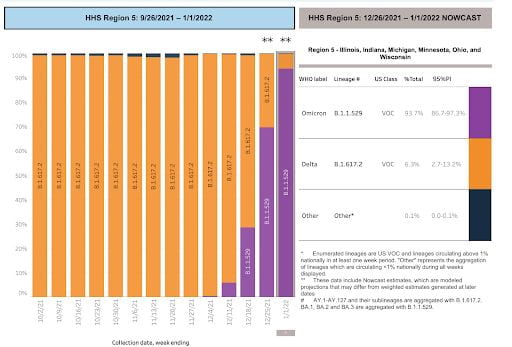
As we know, the new variant, Omicron, is highly contagious. It can be blamed for the majority of the intense spread that is currently ravaging the United States. In this infographic from the CDC’s Data Tracker, the Omicron variant is making up about 93.7% of cases in what they call “Region 5,” which includes Ohio. To put that into a larger perspective, over the entirety of the United States, the Omicron variant makes up about 95.4% of cases.(3)
Now that we have an idea of the type of risk that we are facing as people residing in the US, and especially Ohio, let’s take a look at President Johnson’s email and focus on the university’s policies and their shortcomings.
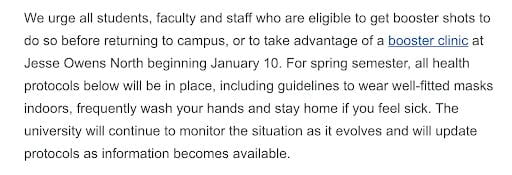
In this excerpt, President Johnson writes, “[t]he university will continue to monitor the situation as it evolves and will update protocols as information becomes available.” There is information currently available to help “update protocols.”
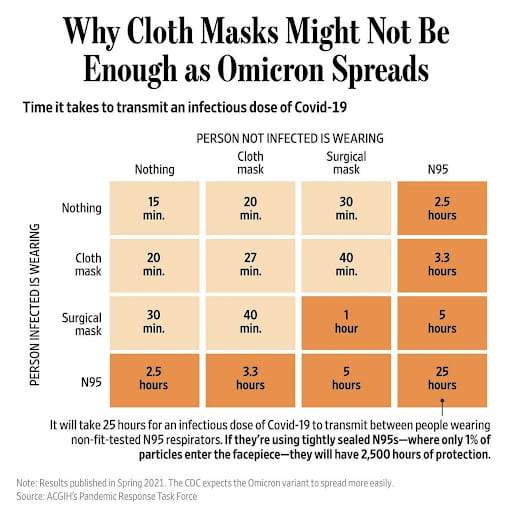
According to a study informed by both the CDC and American Conference of Governmental Industrial Hygienists’ (ACGIH) Pandemic Response Task Force, and provided by the Wall Street Journal, cloth masks worn by both an uninfected and infected individual will still allow transmission of the highly contagious Omicron variant within 27 minutes.4 A single, in-person class at the Ohio State University lasts at least 55 minutes. With cloth masks, in an indoor setting, transmission is essentially guaranteed. President Johnson provided no mention of requiring N95, KN95, or the various other masks of this quality, in classrooms or on campus. Since N95 masks are left to medical workers, KN95 masks are the next best option. However, these masks are in high demand, and prices are rising quickly. As of writing this letter, a single KN95 mask costs $2, a box of 5 is, at the lower end of the pricing spectrum, $15, and a box of 10 costs upwards of $25 dollars.5 Students will most likely not be able to afford to purchase these genuinely protective masks, and therefore the spread will continue uncontrollably as classes proceed in person.
This is not to mention the situation beyond the classrooms, and in the dorms.
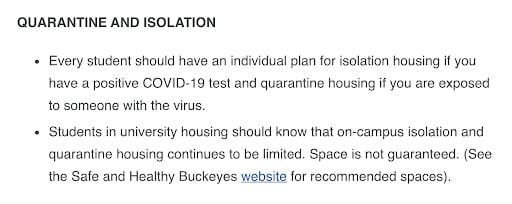
According to this excerpt of President Johnson’s university COVID policies guideline, students who test positive upon arrival, and in general, cannot be in the dorms, and must find housing on their own: “[s]pace is not guaranteed.” Therefore students who test positive, or students who were even in contact with someone who tested positive, must go to a local hotel and pay for their entire stay with their own assets, however few or many those may be. The university is not offering any discounted rates or compensation for the stay. Taking a glance at the hotel list provided on the Safe and Healthy Buckeyes website,6 the Marriott in Worthington charges upwards of $89/night per single person room, and the Marriott in Dublin charges upwards of $149/night for their single person rooms. The Holiday Inn Express Suites OSU runs for upwards of $123/night, Hyatt Place OSU for upwards of $114/night, Staybridge Suites OSU for upwards of $109/night, and Springhill Suites for upwards of $129/night. These rates can all be found on each of their websites. What this email does not cover is that these places may not even have spaces available. There are about 60k+ students on the main campus. The Holiday Inn Express Suites OSU has only two single rooms available at the moment. What will happen once in-person lectures begin?
During both semesters of 2020, President Drake offered housing and meal plan refunds to freshmen and sophomores to allow them to live off campus due to the pandemic. This semester, if students want to defer from living on campus due to the rapid rate of COVID transmission, they must pay approximately $3500 for “violating the contract” as can be observed in this response a student received from University Housing.

Additionally, during those previous semesters there were designated spaces purchased for the housing of infected and exposed students, which were offered at no cost to them. The availability of those spaces helped ensure the safety of our community. The university’s expectations for each infected or exposed person to manage their quarantine and isolation housing on their own, as well as pay for it on their own, is ignorant at best. This move will put the community at even higher risk because many, even most, students will not be able to find a place to quarantine with prices of $100+ per night. This policy fails to mention how meals will be handled as well.
There is a federal fund consisting of millions of dollars, called the “Together as Buckeyes Emergency Fund” that students can apply for due to financial hardship as a direct result of the pandemic. However, this resource was not mentioned nor provided in the email, when its presence in the section regarding isolation and quarantine housing would have been important.
Ultimately, it is clear through President Johnson’s email that neither she, nor the rest of the university’s administration, care about the health and safety of their students. This email and the “policies” included offer no protection nor genuine concern about human lives, and ultimately serve as a strawman and a gesture to save face. Money is, and has always been, the number one priority to the heads of tOSU’s administration.
If this is truly not the case, and you, President Johnson, would like to show us all that we matter more than the money you would be making off our suffering, then it is in your best interest to meet the following demands.
- Ohio State must fully cover lodging for students who test positive or who are exposed to someone who has tested positive. This is possible, as evidenced by it already having been done. This is necessary whether it comes in the form of providing isolation/quarantine housing on campus, or paying for the costs of hotel fees.
- Ohio State must also provide coverage for any other costs associated with such isolation and quarantine, such as meal costs.
- Ohio State must make a commitment to properly socially distancing ALL in-person classes and officially recommending and providing proper, protective PPE.
- Ohio State must authorize all university courses to utilize hybrid or online modes of instruction. This will allow the delivery to be up to the professors, and will help limit the spread of COVID-19.
- Ohio State must require students, staff, and faculty who live off campus, but spend a significant amount of time on campus, to test weekly.
- Ohio State must enforce the testing mandate and hold students accountable. In the past, students could completely ignore the “mandatory” testing and would not receive any consequences for putting others at risk.
While we as students do not have the economic means to put pressure on you financially, and hit you where it hurts, we believe that if you ignore our demands that the financial losses will occur naturally. These demands are not optional, they are required. If you want to continue the semester and see it to its full term, you will meet these demands. If you do not, you will face the consequences of your own hubris and greed. People will get sick by the masses. They will be unable to fulfill the expectations for their classes. Grades will drop dramatically. People will most likely find it to be easier to withdraw from the semester than to continue to struggle and damage their GPAs. Once it gets bad enough, your final and best option will be to shut down the school. You will have to issue refunds, like you had when this pandemic first began. This is your final warning. If you decide to ignore these demands, you will have to look into the eyes of your students and admit your defeat. Meeting these demands is in your best interest.
Don’t say we didn’t warn you.
References
- https://www.nytimes.com/interactive/2021/us/ohio-covid-cases.html
- https://www.nytimes.com/interactive/2021/us/covid-cases.html
- https://covid.cdc.gov/covid-data-tracker/#variant-proportions
- https://www.wsj.com/articles/cloth-face-mask-omicron-11640984082
- https://www.gq.com/story/where-to-buy-better-face-masks
- https://safeandhealthy.osu.edu/quarantine-isolation-hotels?utm_source=sfmc&utm_medium=email&utm_campaign=opres_faculty-staff-student-awareness_fy22_covid-update-sp22&sfmc_id=40463288
